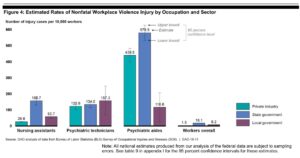Two recently proposed rules from OHSA may have (likely) impact for healthcare and senior living providers. The Department of Labor regulatory agenda is here: Agency Rule List – Spring 2024 (reginfo.gov)
The proposed OHSA rules are expected to be released by the end of the year, which could significantly impact senior living providers. The first rule focuses on preventing workplace violence in healthcare settings. This rule would require healthcare and social service employers to implement comprehensive workplace violence prevention plans to protect their employees.
The second rule aims to protect employees from infectious diseases in the workplace. This rule would cover a range of infectious diseases, including COVID-19, tuberculosis, and others, and would apply to healthcare settings, laboratories, correctional facilities, and emergency response workers.
Workplace Violence Rule
Studies have shown that violence from residents to staff in long-term care settings has not only increased but become normalized. As facilities deal with more complex resident disease states and dementia, agitation and direct outbursts of a violent nature have risen in prevalence.
Direct resident care in long-term care facilities is predominantly carried out by personal support workers and registered practical nurses, most of whom are women. They regularly face physical, verbal, and sexual violence from residents. To investigate this widespread issue, fifty-six staff members in seven communities in Ontario, Canada, were consulted. They identified immediate causes of violence such as resident fear, confusion, and agitation, and underlying causes like task-driven work organization, understaffing, inappropriate resident placement, and insufficient time for relational care. They viewed violence as a symptom of an institution that undervalues both its staff and residents. They described the impact of violence on their health and well-being, including injuries, unaddressed emotional trauma, job dissatisfaction, and burnout. They also highlighted barriers to preventing violence, such as inadequate training and resources, systemic underfunding, lack of recognition of the severity and prevalence of the issue and limited public awareness. Study: Resident violence against long-term care workers has become ‘normalized’ – McKnight’s Senior Living (mcknightsseniorliving.com)

The 2016 Government Accountability Office (GAO) report highlighted the need for OSHA to enhance protections for workers in residential care settings against workplace violence. The report recommended that OSHA assist its inspectors in developing citations, follow up on warnings, and assess the effectiveness of its efforts. The GAO reiterated this recommendation as a priority later that year, emphasizing the need for new resources for key federal departments and agencies. The report is available here: GAO on Healthcare Workplace Violence
Infectious Disease Proposed Rule
The proposed rule on infectious diseases aims to protect healthcare workers, including those in assisted living facilities, from exposure to various infectious diseases such as COVID-19, tuberculosis, chickenpox, shingles, measles, Methicillin-resistant Staphylococcus aureus (MRSA), pandemic influenza, and severe acute respiratory syndrome (SARS). This standard would apply to healthcare settings, laboratories, correctional facilities, and emergency response workers. The proposed rule is available here: View Rule (reginfo.gov)
What will be interesting as these rules become public for review and comment is if any impact from the recent SCOTUS Chevron decision will occur. Between the two proposed rules, the Infectious Disease rule seems redundant to me as healthcare is already subject to dozens of regulations regarding infectious disease prevention, monitoring, etc.
I think some focus on workplace violence as the same pertains to abuse to staff from patients makes sense, but I’d hate to see another overly bureaucratic rule fall on providers who already, have difficulty complying with CMS regulations let alone at the current reimbursement levels (more rules, not sufficient increases in payments).
My post on the Supreme Court Chevron decision is available here: https://rhislop3.com/2024/07/01/scotus-chevron-decision-a-win-for-healthcare/